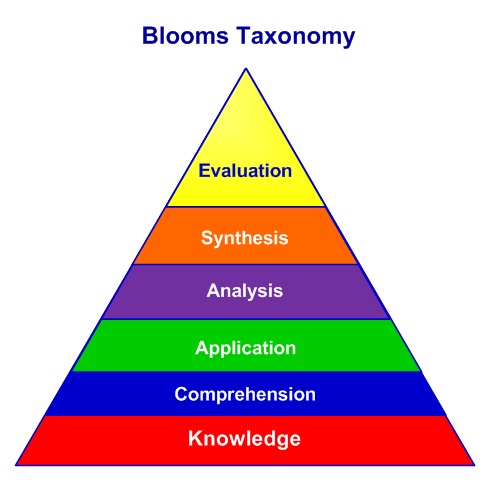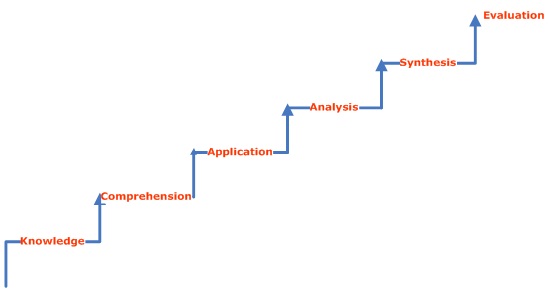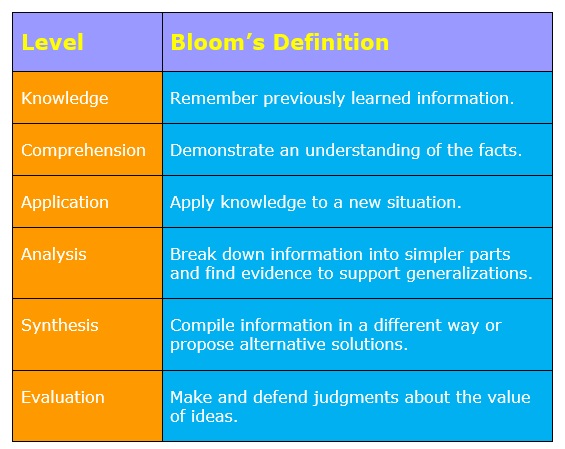Bloom’s Taxonomy
Bloom’s Taxonomy is a classification system developed by educational psychologist Benjamin Bloom to categorize cognitive skills and learning behavior. The word taxonomy simply means classifications or structures. Bloom’s Taxonomy classifies thinking according to six cognitive levels of complexity: knowledge, comprehension, application, analysis, synthesis, and evaluation. The categories are ordered from simple to complex and from concrete to abstract. According to Bloom, each level must be mastered before moving to the next higher level. Each level becomes more challenging as you move higher.
The classification begins at the basic level that is simple recall skills and progresses to the perceived highest level of cognitive processing which they believe to be “evaluation.” The various levels have often been depicted as a stairway to reference a progressive climb to a higher level of thinking. A learner would have to first recall data and then understand it before he or she is able to apply it.
The basic or lowest level in the taxonomy focuses on knowledge acquisition and at this level, people simply memorize, recall, list, and repeat information. In the second level, people are able to classify, describe, discuss, and explain information. At the next tier, people demonstrate, interpret, and apply what they have learned and are able to use the information to solve problems. At the following level, they examine, compare, contrast, and distinguish what they have learned with other information. Then at the second to the highest level, people build a structure or pattern from diverse elements, and are able to put parts together to form a whole. Finally, at the highest level, people make judgments about the value of ideas or materials.
Bloom’s Taxonomy Chart
| Classification | Description of the Classification Level |
| Knowledge |
Recall data or information
|
| Comprehension |
Demonstrate understanding of the meaning and ideas by organizing, comparing, translating, summarizing, and giving descriptions, and can state a problem in one’s own words.
|
| Application |
Use acquired knowledge by applying a concept in a new situation or different way.
|
| Analysis |
Examine and break information or concepts into component parts so that its organizational structure may be understood. Make inferences and able to distinguishes between facts and inferences.
|
| Synthesis |
Compile information in a different way by combining elements in a new pattern or proposing alternative solutions. Build a structure or pattern from diverse elements. Able to put parts together to form a whole.
|
| Evaluation |
Make judgments about the value of ideas or materials and able to present and defend opinions based on a set of criteria.
|
Applying Bloom’s Taxonomy
Bloom’s Taxonomy provides a valuable framework for teachers, trainers, and instructional designers to use to focus on higher order thinking. By providing a hierarchy of thinking, Bloom’s Taxonomy can help in developing performance tasks, creating questions, or constructing problems.
The following chart illustrates the expectation of the learner at each level of the hierarchy and gives some examples of how the learner can demonstrate his or her ability at each level.
| Classification Level | Learner’s Expectation |
| Knowledge | Learner exhibits memory of previously learned material by recalling facts, terms, or basic concepts. Example: List steps in a procedure, names the parts of a bicycle, or recall characters from a novel. |
| Comprehension | Learner demonstrates understanding of facts and ideas by organizing, comparing, paraphrasing, translating, or summarizing main ideas.Example: Explain how the main character felt about what happened to them or summarize what happened in a story. |
| Application | Learner is able to solve problems in new situations by applying acquired knowledge, facts, techniques and rules in a different way.Example: Explain how water bottles could be used to determine the weight of a basket of apples. |
| Analysis | Learner is able to examine and break information into components by identifying motives or causes as well as make inferences and find evidence to support generalizations.Example: Categorize material in groups of recycle and unrecyclable. |
| Synthesis | Learner is able to compile information in a different way by combining elements in a new pattern or proposing alternative solutions.Example: Create a new character and explain how that character would fit into the storyline. |
| Evaluation | Learner is able to present and defend opinions by making judgments about information or validity of ideas based on a set of criteria.Example: Determine if a person acted in a reasonable manner and defend that opinion, or determine if the route taken by an explorer was the best route to take at the time. |
Bloom’s Action Verbs
The following chart provides action verbs for each level of Bloom’s Taxonomy. By creating learning objectives using these action verbs, you indicate explicitly what the learner must do in order to demonstrate learning.
| Levels | Action Verbs |
| Knowledge | Arrange, Define, Describe, Draw, Find, Identify, Label, List, Match, Memorize, Name, Order, Outline, Quote, Recognize, Recall, Recite, State, Tell, Write |
| Comprehension | Classify, Convert, Conclude, Demonstrate, Describe, Discuss, Distinguish, Explain, Generalize, Identify, Illustrate, Interpret, Indicate, Infer, Paraphrase, Predict, Report, Rewrite, Restate, Review, Summarize, Translate |
| Application | Apply, Change, Choose, Compute, Demonstrate, Discover, Dramatize, Employ, Illustrate, Interpret, Interview, Manipulate, Modify, Predict, Prepare, Produce, Select, Show, Solve, Transfer, Use |
| Analysis | Analyze, Appraise, Breakdown, Categorize, Characterize, Classify, Compare, Contrast, Debate, Deduce, Diagram, Differentiate, Discriminate, Distinguish, Examine, Illustrate, Infer, Outline, Relate, Research, Separate, Subdivide |
| Synthesis | Arrange, Assemble, Categorize, Combine, Comply, Compose, Construct, Create, Design, Develop, Devise, Formulate, Generate, Integrate, Invent, Perform, Plan, Propose, Reconstruct, Relate, Reorganize, Revise, Rewrite, Synthesize |
| Evaluation | Appraise, Argue, Assess, Choose, Conclude, Critic, Decide, Defend, Estimate, Evaluate, Interpret, Judge, Justify, Predict, Prioritize, Rank, Rate, Value |
Links
References
Bloom, B. S. (1956). Taxonomy of Educational Objectives: The Classification of Educational Goals. Handbook 1; Cognitive Domain.
Overbaugh, R. & Schultz, L. “Bloom’s Taxonomy.”
Krathwohl, D. R. (2002). “A Revision of Bloom’s Taxonomy: An Overview.” Theory into Practice
Clark, D. (2010). Bloom’s taxonomy of learning domains: The three types of learning. Big Dog & Little Dog’s Performance Juxtaposition.



